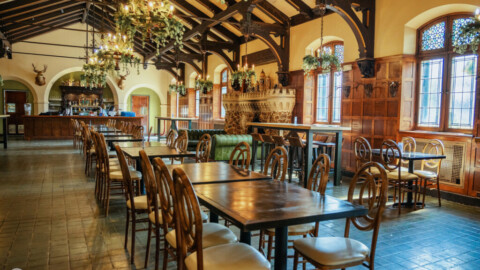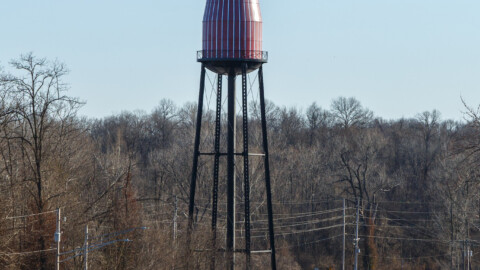
photo by Dan Henrichs
Named after the Peabody Darst Webbe housing complex that has since been razed, the neighborhood has experienced many turbulances over it long history. Much like its vertical high-rise cousin to the north, Pruitt-Igoe, the low income housing experiment at Peabody Darst Webbe imploded due to systemic neglect, and the neighborhood became synonymous with crime for many years. Today, the horizontally laid out mixed income housing that exists on the footprint of the community’s namesake project is much better scaled, and the area has seen notable development projects (like the condo conversion of the former City Hospital) take shape.

photo by Joe Rakers

photo by Ginger Johnson

photo by Mike Matney

photo by Ann Aurbach

photo by Ryan Stanley
In 1961, the Peabody Darst Webbe neighborhood, so named for the three prominent groupings of apartment buildings, would have been thrumming with activity and flush with new residents. On the city’s northside, the Pruitt-Igoe complex was still a topic of general celebration, and was a key motivator in the construction of the vertical towers in PDW. In the St. Louis Housing Authority, which managed both Pruitt-Igoe and Clinton-Peabody/Darst-Webbe, civic leaders had reason to believe that the city’s poverty problem was on the road to rectification. Perhaps more significantly though, in public housing projects like these, those leaders now had a pathway toward clearing areas of the city (of buildings and of people, mostly African-American but others too- the city’s Chinatown was torn down during this time period) closer to Downtown for future development.

photo by Jason Gray

photo by Donna Burch

photo by Mike Matney
Unfortunately, the 1950’s and early 60’s in St. Louis was still an era of “quiet” segregation (i.e. restrictive deed covenants, redlining, etc.), and the new, vertical towers on the city’s north and southsides only served to intensify the problem. In fact, the St. Louis Housing Authority’s tenant management practices at its Darst-Webbe properties was the subject of a racial discrimination/fair housing lawsuit in the 2000’s that went all the way to Federal Court. In addition to the problem of racial isolation in these buildings that remained unmitigated even after the U.S. Supreme Court decisions that made enforced segregation illegal, the St. Louis Housing Authority underfunded maintenance, and in some cases infrastructure, for the properties it managed. As a result, elevators (in high-rise buildings) failed, causing residents to have to climb stairs over several stories to get to their apartments, trash went uncollected and began to pile up, causing sanitation problems, and things that broke, like playground equipment or stair rails, went unfixed, causing numerous safety issues. In less than two decades, those vast public housing projects in St. Louis, which had once garnered national attention, became areas of real concern, increasingly of crime and general health. Most of the Peabody Darst Webbe apartment buildings were demolished in 1999, and were replaced with the current, two-story, mixed income properties.

photo by Ann Aurbach

photo by Vivian Nieuwsma

photo by Dan Henrichs

photo by Jackie Johnson
Going back briefly to an even earlier time in this neighborhood, the St. Louis City Hospital (now the Georgian Condominiums) was constructed in 1846, just a few years prior to the establishment of St. Louis first public park, Lafayette (just west of the hospital). A series of calamities shaped and reshaped the growing hospital complex, including a devastating fire in the late 1850’s and the third deadliest tornado in U.S. History in 1896. By 1970, the ten-acre site included more than 10 buildings, and had served the city as its primary hospital for over 100 years. The hospital closed in 1985, when the City Hospital relocated to just north of Delmar Boulevard. After 2000, several buildings were razed and what remains is undergoing renovation and new life as private housing and a commercial development. In 2013, a 50,000 square foot dental school (AT Still University) was constructed on the footprint of the old hospital complex, underscoring growth in the area.

photo by Sharon Keeler

photo by Ryan Stanley

photo by Harper Gray
Today, the neighborhood seems to be stabilizing. Recent censuses show a slowly rising population, and one which is becoming more diverse (both great things). Due to thoroughfares like I-44 and Truman Parkway, walking from Peabody Darts Webbe to adjoining neighborhoods can be a little cumbersome (and what is up with the giant fence closing off the Dolman corridor from the rest of the neighborhood?). Still, the central location and nearby amenities are plenty attraction for some, and when you get down into the mixed income area of the neighborhood, there is a definite sense of community. For a section of the city scarred so long by divisive practices, it feels like Peabody Darst Webbe is finally on a positive trajectory.

photo by Jason Gray

photo by Donna Burch

photo by Ann Aurbach

photo by Dan Henrichs
Map available here.
Our end point for Photo Flood 57 was the lovely Park Avenue Coffee, just to the west of the neighborhood. It is a busy little cafe with a pleasant patio in the back, and great drinks and bakery bites.

photo by Dan Henrichs








